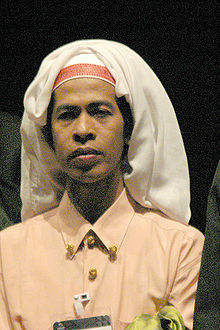Gender in Bugis society
Contributors to Wikimedia projects
The Bugis people are the most numerous of the three major ethnic groups of South Sulawesi, Indonesia.[1][page needed]

In contrast to the two-gender system, Bugis society recognises five genders: makkunrai, oroané, bissu, calabai, and calalai.[2] "Oroané" and "Makkunrai" are comparable to cisgender men and women, respectively.
Bissu are androgynous shamans. Calalai and calabai are respectively approximately equivent to trans men and trans women.[2]
In daily social life, the bissu, the calabai, and the calalai may enter the dwelling places and the villages of both men and women.[citation needed]
Bissu
The bissu belong to one of the five genders of the Bugis. There are divergent theories regarding the definitive origins and meaning of "gender transcendent", as they are commonly called.[3]
For one to be considered bissu, all aspects of gender must be combined to form a whole. It is believed that you are born with the propensity to become a Bissu, revealed in a baby whose genitalia are ambiguous. Ambiguous genitalia alone cannot ensure that you become a bissu. Moreover, these ambiguous genitalia need not be visible; a normative male who becomes a bissu is believed to be female on the inside. This combination of sexes enables a 'meta-gender' identity to emerge.[4]
Bugis society has a cultural belief that all five genders must co-exist harmoniously.[citation needed]
Calabai
According to the Bugis gender system, calabai are false women and so are generally assigned male at birth but take on the role of heterosexual females. Their fashions and gender expression are distinctly feminine but do not match that of "typical" cisgender women.
If there is to be a wedding in Bugis society, more often than not calabai will be involved in the organization. When a wedding date has been agreed upon, the family will approach a calabai and negotiate a wedding plan. The calabai will be responsible for many things: setting up and decorating the tent, arranging the bridal chairs, bridal gown, costumes for the groom and the entire wedding party (numbering up to twenty-five), makeup for all those involved, and all the food. Rarely did I attend a village wedding with less than a thousand guests. On the day, some calabai remain in the kitchen preparing food while others form part of the reception, showing guests to their seats.
— Sharyn Graham
Calalai
The calalai are assigned female at birth but take on the roles of heterosexual males. They dress and present themselves as men, hold masculine jobs and typically live with female partners to adopt children.[5][page needed]
See also
References
- ^ Peletz, Michael G. (2009). Gender Pluralism: Southeast Asia Since Early Modern Times. Routledge. ISBN 978-0-415-93161-8. OCLC 351812201.
- ^ a b Graham Davies, Sharyn (2006). Challenging Gender Norms: Five Genders Among Bugis in Indonesia. Case Studies in Cultural Anthropology. Thomson Wadsworth. p. xi. ISBN 978-0-495-09280-3. OCLC 476076313.
- ^ "Sex, Gender, and Priests in South Sulawesi, Indonesia" (PDF). International Institute for Asian Studies. Retrieved 25 July 2011.
- ^ "Sulawesi's fifth gender". Inside Indonesia. Archived from the original on 28 July 2012. Retrieved 25 July 2011.
- ^ Carl, John D. (2011). Think Sociology (2nd ed.). Upper Saddle River: Pearson. OCLC 663102354.
Further reading
- Graham Davies, Sharyn (2010). Gender Diversity in Indonesia: Sexuality, Islam and Queer Selves. ASAA Women in Asia Series. Routledge.
- Pelras, Christian (1997). The Bugis. The Peoples of South-East Asia and the Pacific. Wiley-Blackwell. ISBN 978-0-631-17231-4. OCLC 247435344.
External links
- Five Genders? (video). National Geographic Channel. 21 October 2008 – via YouTube.
- Perkins, Roberta (November 1994). Skinner, Craig (ed.). "Soft Minded Men: South-East Asian Gender Crossing". Polare (5). Archived from the original on 27 September 2013.